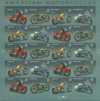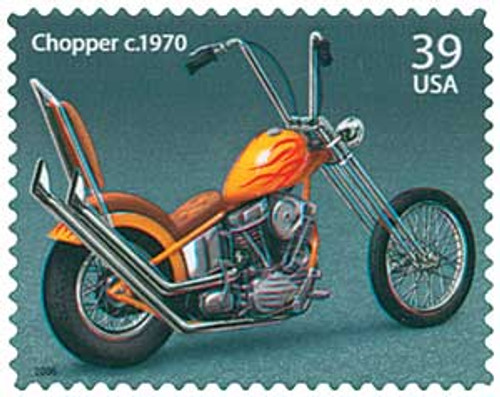
2006 39c American Motorcycles
# 4085-88 - 2006 39c American Motorcycles
$1.50 - $30.00
U.S. #4085-88
American Motorcycles
American Motorcycles
Issue Date: August 7, 2006
City: Sturgis, SD
Quantity: 85,000,000
Printed by: Avery Dennison
Printing method: Photogravure
Perforations: Die cut 10 ¾ x 10 ½
Color: Multicolored
Please note: Due to the layout of the pane, the se-tenant may or may not be provided in Scott Catalogue order.
City: Sturgis, SD
Quantity: 85,000,000
Printed by: Avery Dennison
Printing method: Photogravure
Perforations: Die cut 10 ¾ x 10 ½
Color: Multicolored
Please note: Due to the layout of the pane, the se-tenant may or may not be provided in Scott Catalogue order.
Bicyclist Oscar Hedstrom designed a powered, two-wheeled cycle that became the Indian motorcycle of 1902. By World War I, Indian had become the largest motorcycle manufacturer in the world. Indian survived the Great Depression, then made motorcycles for the Allies during World War II. The company failed after the war, however, and manufacture stopped in 1953.
William Harley and Arthur Davidson produced their first motorcycles in 1903. Police departments and the military bought them for their power and speed. After World War I, Harley-Davidson succeeded Indian as the world’s largest manufacturer of motorcycles.
In 1915, the Cleveland Motorcycle Company began making a two-stroke, single-cylinder machine. The 1918 Cleveland motorcycle had a top speed of 40 miles per hour. About 150 pounds, it was one of the most popular light motorcycles of that time. The company, however, did not make it through the 1930s.
World War II veterans wanted bikes like the light machines they had seen in Europe. First, they removed or shortened the fenders. Then, they removed or “chopped” unnecessary parts, like the windshield, front fenders, big headlights, crash bars, and big seats. The modified motorcycles were known as “choppers.”
U.S. #4085-88
American Motorcycles
American Motorcycles
Issue Date: August 7, 2006
City: Sturgis, SD
Quantity: 85,000,000
Printed by: Avery Dennison
Printing method: Photogravure
Perforations: Die cut 10 ¾ x 10 ½
Color: Multicolored
Please note: Due to the layout of the pane, the se-tenant may or may not be provided in Scott Catalogue order.
City: Sturgis, SD
Quantity: 85,000,000
Printed by: Avery Dennison
Printing method: Photogravure
Perforations: Die cut 10 ¾ x 10 ½
Color: Multicolored
Please note: Due to the layout of the pane, the se-tenant may or may not be provided in Scott Catalogue order.
Bicyclist Oscar Hedstrom designed a powered, two-wheeled cycle that became the Indian motorcycle of 1902. By World War I, Indian had become the largest motorcycle manufacturer in the world. Indian survived the Great Depression, then made motorcycles for the Allies during World War II. The company failed after the war, however, and manufacture stopped in 1953.
William Harley and Arthur Davidson produced their first motorcycles in 1903. Police departments and the military bought them for their power and speed. After World War I, Harley-Davidson succeeded Indian as the world’s largest manufacturer of motorcycles.
In 1915, the Cleveland Motorcycle Company began making a two-stroke, single-cylinder machine. The 1918 Cleveland motorcycle had a top speed of 40 miles per hour. About 150 pounds, it was one of the most popular light motorcycles of that time. The company, however, did not make it through the 1930s.
World War II veterans wanted bikes like the light machines they had seen in Europe. First, they removed or shortened the fenders. Then, they removed or “chopped” unnecessary parts, like the windshield, front fenders, big headlights, crash bars, and big seats. The modified motorcycles were known as “choppers.”














